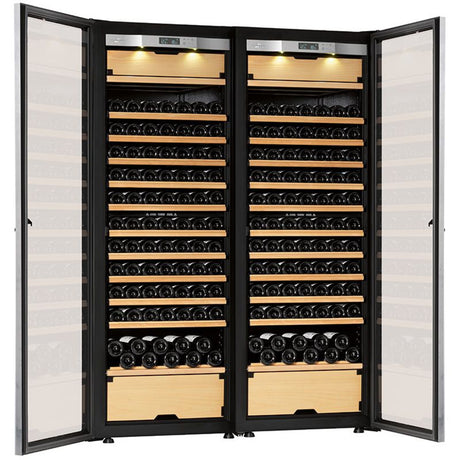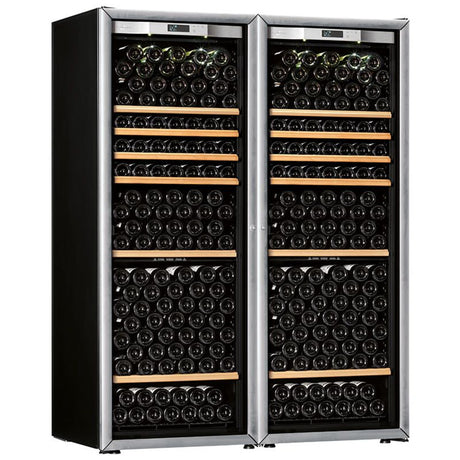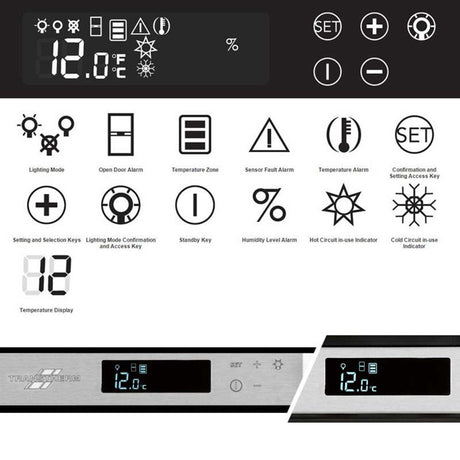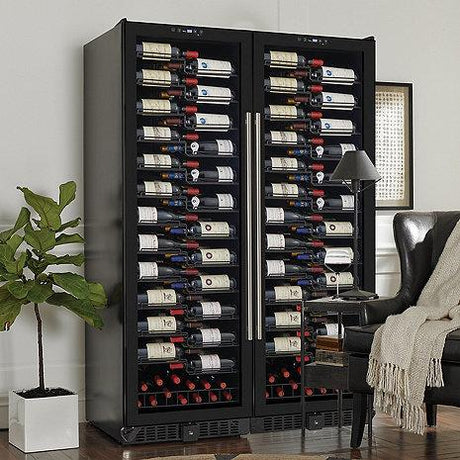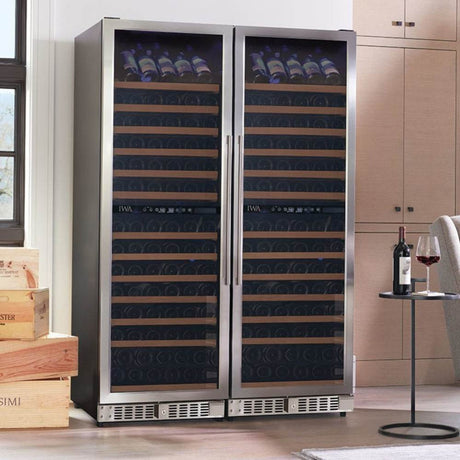Shop 14 WCHQ Extra Large Wine Fridges for 300+ Bottles Products
-
-
-
-
-
-
-
-
-
-
-
Sold out
-
-
-
Sold out
Benefits
Large wine fridges aren’t just about the storage of wine. They enable you to enhance your wine experience, help aging, and wow your guests. Let’s take a look at the many benefits that come with making this kind of investment.
Optimal preservation
These fridges are able to regulate both humidity and temperature. This allows your wines to age with grace and keep their flavors and character.
Versatile storage
The fridges are suitable for whites, reds, rosés, and sparkling wines. You can set specific temperatures to different temperatures for the benefit of various wine types.
Enhance your hosting
When you have a variety of wines available that are chilled to perfection, your social gatherings including dinner parties acquire an even bigger sense of sophistication.
UV protection
Quality wine fridges tend to come complete with UV-protected wind doors. These stop damaging rays from altering the flavor of your wines for the worse.
Vibration damping
The fridges also have reduced vibration which prevents sediments from being disturbed. This will protect the integrity of your wine.
Space efficiency
Although the fridges can be very spacious on the inside, many of them can seamlessly fit into your kitchen, bar, or cellar.
Flexible shelving
Shelves can be adjusted or removed to house larger bottles. You can often customize the space to meet your specific needs.
Show off your collection
Many fridges have a sleek design alongside interior lighting. They are designed to help you showcase your wine collection with pride and make the labels clearly visible from the outside.
Compatible with accessories
You can pair these fridges with various accessories like vacuum sealers, aerators or even phone apps which help you to manage your collection.
Energy efficiency
Modern wine fridge designs tend to focus on eco-friendliness to ensure your wines are chilled without excessive energy being consumed.
Locks and alarms
Many of these models with inbuilt locks and alarm systems to help you keep your collection safe.
Seamless integration
The fridges tend to be compatible with various kitchen and bar designs.
How to choose
Capacity
If you have a small collection of 50-100 bottles, opt for a smaller fridge. These are ideal for people who are just starting a wine collection or don’t have much space.
If you have 100-300 bottles, you could opt for a medium fridge. These are best for regular wine drinkers who have a growing collection.
A larger wine fridge is ideal for people who have 300 bottles or more. These models are perfect for passionate connoisseurs or those who want to invest in wine storage.
Temperature zones
Single zone: This maintains one temperature throughout and is ideal for storing a single wine type.
Dual or multiple zones: Fridges with dual or multiple zones enable you to store different wines at their optimal temperatures at the same time.
Shelving
Wire racks: can be durable and cost-effective, but they don’t always slide out.
Wooden shelves: have vast aesthetic appeal and can reduce vibrations, which can disturb your wine.
Sliding shelves:
Vibration
Compression-based: Powerful and able to cool larger spaces but can create slight vibrations.
Thermoelectric: Almost silent and free from vibrations but aren’t always as efficient as larger systems.
UV Protection
Tinted glass doors: can protect wines from damaging UV rays that can compromise the quality and flavor of wine.
Solid doors: give you total protection from UV rays but lack visibility.
Door style
Think about swing direction and whether a left or right hinge will suit your space.
Lockable: Gives you an additional layer of security, which is great for those storing more expensive wines.
Humidity control
Perfect for maintaining cork integrity and the prevention of mold. Some models have built-in humidity sensors or can add moisture.
Energy efficiency
Seek out a model that has energy-saving features or has been rated by an energy-efficiency body to benefit from long-term energy savings.
Design and aesthetics
Built-in vs freestanding: Built-in models are designed to fit into cabinets, but you can place a freestanding unit anywhere.
Finish: Black, stainless steel and custom panels may match your home décor.
Additional features
Digital displays allow for both precise temperature control and monitoring, whilst LED lighting gives you fantastic visibility and an extra dash of elegance without the production of heat. Reversible doors can be adapted to open either from the left or the right depending on the layout of your room.
Price and warranty
Make sure the unit is right for your budget and comes with a generous warranty for your peace of mind.
Racking flexibility
Some fridges have adjustable racks to ensure different bottles fit comfortably and storage space is maximized.
Vibration dampening
It’s best to store wine with minimal disturbance. High-quality fridges have technology that reduces vibration both from the compressor and external sources. Excessive vibration can compromise the quality of your wine over time, which is why it’s so important to create a stable environment.
Air filtration
The quality of the air inside your fridge is very important. Some units have inbuilt carbon filters which eliminate unpleasant odors which can seep into corks and affect the flavor of your wine.
Door swing clearance
Make sure you measure the space where your fridge will be going and consider the door swing. You don’t want to place the fridge in a location where you can’t fully open the door.
Security features
Features like a locking mechanism can be ideal if you have expensive or rare bottles. It can also be useful if you have children around.
Energy consumption
Bigger fridges can consume a great deal of energy. Seek out a unit that has energy-saving features or one that has a high energy efficiency rating. This can help you make big energy cost savings over time.
Types
Single zone fridges
These have one cooling zone, allowing you to maintain a consistent temperature throughout. They’re great for people who mainly consume one kind of wine. Different wines have different temperature requirements. Constant temperatures can also help you stop wine from premature aging.
Dual-zone fridges
These have two distinct temperature zones, enabling you to store red and white wines at optimal temperatures. They’re ideal for people who regularly consume different kinds of wine. Some of these models have humidity control features that keep your corks moist.
Built-in fridges
These fridges are designed to fit seamlessly into cabinets or under countertops and often come with front venting. They’re great for people requiring a sleek solution that will help them save space without compromising storage space. Many of these units have UV-resistant glass doors protecting your wines from damaging light.
Freestanding fridges
These versatile units can be placed anywhere inside your space if you have sufficient ventilation. They’re great for wine consumers seeking flexibility and people who like to move the items in their collections around. You need to ensure these fridges have space around them to prevent overheating.
Thermoelectric fridges
These fridges utilize the Peltier effect for cooling. This gives you quieter, vibration-free operation. The units are great for those concerned about disturbance or potential vibration, which could affect the sediment of their wine. These units tend to be more energy-efficient than compressor-based options.
Compressor-based fridges
Compressor-based fridges operate similarly to standard refrigerators and deliver efficient, powerful cooling. They’re a good match for people with large collections who require robust cooling. They are very popular with people who live in warmer locations. Modern technology has made today’s compressors quieter than ever before.
Alternatives
Long-term storage
A traditional wine cellar could be ideal if you need an alternative for long-term storage. They can be built underground or at ground level, so you can benefit from the naturally cool and humid conditions. Traditional wine cellars are great for people with large collections who have the resources to both construct and maintain a cellar.
Space-saving storage
Wine wall units and wine cabinets can be ideal for those seeking an alternative to a wine fridge. They can be built into walls or operate as standalone furniture pieces. Perhaps you want to create a wine display area but are eager to protect the quality of your wine? If so, these options could be ideal.
Temperature and humidity control
Multi-zone wine coolers are designed to cater to lovers of both red and wine wines in a single unit.
They’re great for people requiring varied temperature settings but don’t have much space.
Rapid cooling or serving storage
Countertop wine chillers are designed to cool wine bottles quickly and maintain them at serving temperature. They are great for regular entertainers and people with limited collection requirements.
Portable wine storage
Wine storage cases often have foam inserts to protect your wine. They can have hard or soft-shell cases. They’re great for people who regularly travel with wine or take bottles to events. They can offer a great deal of convenience.
Post Purchase Considerations
Location
If you are worried about where to place your unit, seek out one that has enough space for accessibility and ventilation. Make sure the floor is sturdy. If you’re placing the unit on an upper floor, check the load-bearing capacity of the floor. Basements and ground floors can be ideal.
Temperature stability
You may worry about ambient room temperature fluctuations affecting your fridge's cooling efficiency. Make sure your fridge is kept away from radiators, direct sunlight, and larger appliances that can emit heat. A separate thermometer can help you verify internal temperatures.
Humidity
If conditions are extremely dry, corked wines can lose their seal. Try to maintain a humidity of 60-70%. A hygrometer will help you monitor humidity. If humidity levels are low, you can add a small container or water to boost humidity levels.
Vibration and noise
Constant vibrations can disturb wine sediment and affect taste. Make sure the unit sits on a stable surface. You can keep the unit level via the use of a leveling tool or adjustable feet. Don’t place the unit in a high-traffic area or close to loud machinery.
Storage capacity
Overstocking can cause inadequate overflow and affect cooling. Leave enough space for air to circulate rather than filling each rack. You should also rotate your wines regularly.
Energy consumption
Larger appliances can cause energy bills to rise. If the fridge has energy-saving settings, make sure you use these. Ensure the door is sealed tightly when you’re not using it. Please place it in a cool area to reduce energy strain.
Maintenance and cleaning
Dust and wine spills can reduce the efficiency of your unit. Carry out regular spillage checks, especially after adding new bottles. Use a soft cloth and mild detergent to clean the unit. Vacuum the rear coils annually to ensure operation remains efficient.
FAQs
What is the best temperature for storing wine?
It’s best to store wine between 55-58°F (13-15°C) for reds and 49-55°F (9-13°C) for whites. Check the wine manufacturer's instructions for specific details.
How can a bigger fridge benefit my collection?
A larger fridge will allow you to store a mix of bottle sizes and types. This enables you to grow your collection over time and keep wines at their optimal temperatures thanks to efficient circulation.
Is humidity control important?
Yes. Maintaining a humidity level of 60-70% is best to stop corks from drying out and aid the aging process.
Can red and white wines be stored in the same unit?
Yes. Many wine fridges have dual and multi-zone temperature controls to store different wines at the right temperatures.
How will UV protection benefit my wine?
Ultraviolet rays can cause wine to degrade over time. UV-resistant doors can defend wines from harmful light and preserve character and flavor.
How energy-efficient are wine fridges?
Most of today’s wine fridges are built with energy efficiency in mind. Look at the specifications to determine a specific unit’s energy ratings.
Do these fridges have security features?
Many of these models come complete with lock and key features to protect your collection. These are ideal for those storing valuable or rare wines.
How often do I need to maintain my fridge?
Wine fridges only need minimal maintenance if you treat them carefully. It’s helpful to clean and inspect them periodically so you can ensure performance is optimized.
Can fridges be integrated into cabinetry or my kitchen layout?
Built-in models are available for seamless integration, and you can also buy free-standing units.


